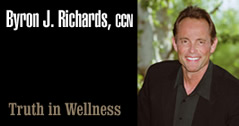WHAT'S
IN YOUR
MULTIPLE VITAMIN?
PART 1
By Byron J. Richards, CCN
April 25, 2008
NewsWithViews.com
Junky vitamins are often passed off as quality, and many times are endorsed by a physician or celebrity. There are many tricks that low quality supplement companies use to hide their poor quality, spending more money on marketing than on what is under the hood.
As a leading nutritional expert and owner of a dietary supplement company (Wellness Resources) I am often asked to explain the subject of quality. Because so much is out of view of the consumer, including the details of the raw materials used in any product, the best way to get a handle on the subject is to look at a company’s multiple vitamin and mineral products. This can help you see through the spin and understand that company’s actual production philosophy.
When I plant what goes into a dietary supplement I can purchase almost any nutrient ingredient in various shades of quality, ranging from the low end to the very high end. Because my company evolved over 23 years by helping people who had lost their health and my priority as a health professional was fixing their health, I focus on the high end in my products – a philosophy represented by about 1% of the dietary supplement industry. Since 99% of the industry touts its quality, there is a major discrepancy between marketing hype and reality.
Beware of Really Cheap Minerals
Minerals are vital nutrients for health, required for numerous enzymes in your body to work properly. Minerals in food are at low levels due to excessive processing of food, poor farming that depletes our soils, as well as the use of pesticides that interfere with the natural sulfur cycle – leaving us not only with chemically adulterated food but food that has lower nutritional value. It is now common sense to supplement fine quality minerals, including important trace minerals.
These minerals are in any company’s multiple vitamin as well as bone-related products. Minerals from the ground are referred to as inorganic, whereas minerals in plants or crops are structured by living cells and thought of as organic (as different from how the word organic describes food that doesn’t contain pesticides).
The cheapest form of calcium is gym chalk, otherwise known as inorganic calcium carbonate. Other ground up rock forms of cheap calcium include bone meal, oyster shell, or dolomite. Another cheap form is calcium gluconate (9% calcium and 91% sugar glucose). These forms of calcium require large amounts of hydrochloric acid to make bioavailable, thus they have poor absorption (which is why they are used as over the counter antacids). Once in your body they are not very biologically useful and run a risk, depending on your underlying health, of calcifying your arteries, causing alarming breast lumps, gall stones, or kidney stones. There is little chance such poor quality calcium will help your bones.
Magnesium oxide is the cheapest form of magnesium, often appearing in products using low quality calcium. Oxides need antioxidants to deactivate them once they are absorbed. There is no excuse for using a mineral form that uses up valuable antioxidants, unless of course you could care less about the person taking it. Products containing inorganic calcium carbonate and magnesium oxide belong in the trash – most likely with any other product made by such a company.
Which Minerals are Best?
Minerals for dietary supplements are typically bound to another substance. What they are bound to has a profound affect on how they are absorbed and even more importantly – where they go and what they do in your body.
Calcium citrate (20% calcium, 80% citric acid) is known to be better absorbed than inorganic calcium carbonate. However, taking 1000 mg of calcium citrate gives you 4000 mg of citric acid, like eating a pound of tomatoes. This much citric acid can conk out your cell engines (mitochondria) by flooding their citric acid cycle with too much citrate (like flooding a car with gas). Individuals who are tired or fatigued often respond poorly to high amounts of citric acid, making them even more tired or giving them headaches. Since your cells have no way to efficiently use so much citric acid, calcium citrate is not a high quality form of the mineral to use on a daily basis. Small amounts don’t matter – large amounts are a definite energy-related problem for too many people.
In an effort to get away from magnesium oxide some companies have gone to another cheap salt form known as magnesium aspartate (20% magnesium, 80% aspartic acid). Aspartic acid in small amounts is commonly found in food and of no harm. In larger amounts it adds to excitement in the nerves – which is not good if nerves are already stressed (it can act as an excitotoxin if consuming a lot of it). Aspartate is never a good choice as the primary form of magnesium or calcium in any dietary supplement.
What you really want are minerals in forms that not only absorb well but also do something useful. For example, in my multiple vitamin I use magnesium malate (and no citrate), because this form not only absorbs well but the malic acid is also another valuable nutrient. It goes into cells (taking the magnesium with it), and actually helps turn on the energy-producing citric acid cycle. This is a totally different reaction than citric acid. Malic acid induces cell energy production to go forward and is the most lacking Krebs citric acid cycle nutrient when there is fatigue.
I use a variety of calcium forms in products I design; based on the theme that not only the calcium but whatever it is bound to can both be useful to your body. For example, calcium AEP helps strengthen your nerves so you can tolerate stress better, as the AEP is a great nerve nutrient. Calcium taurate helps relax your nerves, as taurine is a known relaxant.*
In bone formulas I like part of the calcium in the form of microcrystalline hydroxyappetite (MCHC - small particles of intact bone), as these act as a true bone food and can readily be absorbed, transported to your bones, and easily attached to the existing bone matrix.*
Is Coral Calcium any Good?
Depending on the coral calcium type, it can be a great dietary supplement. Coral calcium from ocean waters has a natural ratio of 2 parts calcium to 1 part magnesium, along with many other trace minerals found in the ocean. It is typically harvested from dead coral reefs in the pristine waters off the coast of Okinawa (it is not an eco-unfriendly harvesting activity). Reputable companies assay the raw material to ensure its quality for human consumption. Bone health of the citizens of Okinawa is legendary.*
These forms of calcium and magnesium are in a carbonate structure, but far different than the gym chalk described above. They exist in highly organized geometric structures, organically formed by the living coral reefs (like a true food form). They are the only form of minerals that are both fat and water soluble and are better absorbed than citrates. They rapidly produce mineral ions that your body can easily use in countless metabolic processes.*
Beware of companies selling coral calcium that has been harvested from the land. This form of the mineral has been “weathered” and has the natural magnesium and trace minerals washed away. In Japan they use this form to make concrete for their roads. It is sold as a dietary supplement to unsuspecting customers in the U.S. thinking they are getting real coral calcium. These companies always add cheap magnesium back into the product and have to list it on their label (typically magnesium oxide). Thus, if you have a coral calcium product with added magnesium oxide – throw it away.
What Are Amino Acid Chelates?
The ability to bind a mineral to a protein is one of the great advances in mineral biochemistry and human nutrition. Quality companies always disclose the specific amino acid used in the chelating process – how else will you know what you are taking? Quality companies like to brag amount their amino acid chelates because the good ones not only cost more to put in a product but the amino acids themselves are also useful to your health. For example, I use a lot of magnesium glycinate in my products. Glycine, an amino acid, is a natural relaxant as well as a great detoxifying nutrient. Truly high quality amino acid chelates perform double duty in your metabolism.
Unfortunately there are a lot of amino acid chelates out there that you have no idea what you are taking. They are always listed as “amino acid chelate” on the label, which is a legal description of what they are and a great way to hide the quality they are not. Any time you see the phrase “amino acid chelate” used to describe the form of a mineral know the company has something to hide. If they were actually proud of what was in their product they would tell you what it is.
This amino acid chelate nonsense has been going on for a number of years but reached a new peak with the introduction of a branded form of these chelates called Biokey®, which are used in one product line promoted by a well known alternative health physician. The Biokey website does not disclose the forms of minerals used or the amino acids used. When I called the company I was stonewalled when I asked what they were.
Biokey® minerals were used in animal nutrition long before human nutrition and it is interesting that the animal website was much more forthcoming with information. As it turns out all of these minerals are chelated using hydrolyzed soy protein. Nowhere on any human product label does it say they contain soy (which is not legal according to current FDA allergy rules for labeling). On top of that, unless soy is specified as non-GMO it is now GMO and contains toxins genetically spliced into the proteins.
The animal website also disclosed the actual nature of the minerals used. For example, the calcium is in the form of calcium formate. Calcium formate is an approved food additive, but the formate part does have to be detoxified, is not that easy for human’s to clear, and is implicated in methanol intoxication. In industry calcium formate is used to accelerate concrete setting. Thus, someone consuming their calcium thinks they are taking (calcium – Biokey® amino acid chelate), a more absorbable form of calcium. Yes, it absorbs nicely and delivers a package consisting of GMO-containing soy, calcium, and formate.
In my opinion you should avoid any product that contains amino acid chelates that do not disclose what they are.
Tablets vs Capsules
High quality minerals take up a lot of physical space, meaning you have to take more capsules of them to reach higher levels of mineral intake that are optimal for bone health. Thus, low quality calcium is often compressed into a tablet. Tablets have to be glued together and coated. They are hard to break down and it is common, especially with mineral-containing tablets, that they pass through your digestive tract and never break down.
Any company that places multiple vitamins or minerals into a tablet does not have your best quality interests in mind. As soon as you see any company’s multiple vitamin or main mineral products in a tablet – run for cover!
Capsules are best and veggie caps (Vcaps) are safer than beef gelatin. Veggie caps are made of vegetable cellulose and are easy for your digestive system to dissolve. There is a concern about mad cow disease, which has resulted in companies that care mostly using veggie caps. They are more expensive and add about $2.00 to the retail cost of a product – a small price to pay for the assurance that prions won’t be eating your brain.
What About Liquids?
Liquid minerals are mostly in the sulfate or chloride forms. Taken orally they tend to be rather nauseating and very hard to use – not to mention they are not superior forms of the nutrients. They are fairly stable in water. Ionic minerals make good electrolyte drinks, but are not a good way to get higher amounts of needed minerals.
Liquid products that contain vitamins often make wild claims about being more absorbable. The reality is that fine grade nutrients (especially B vitamins) will rapidly degrade in any liquid form and lose their biological activity. It is unlikely that any of them hold their potency for more than a few weeks. If the FDA clamped down on these companies (and one day they will), it would quickly be discovered that their label claims for potency at time of expiration are wishful thinking. Don’t waste your money.
Summary
If you are counting on your dietary supplements to support your health then quality is the number one issue that determines their effectiveness. Much of what goes into any company’s multiple vitamin is not clear from the label. However, there is enough information on the label to help you understand how that company truly views quality.
|
Subscribe to the NewsWithViews Daily News Alerts! |
The types of minerals used, which for the most part must be disclosed on the label, can help the savvy consumer understand the real quality that went into the bottle. Most companies are banking on the idea that you will never figure any of this out – and just listen to their hype. Check your multiple vitamin and mineral products against the information in this article and you will quickly see what I mean when I say that only 1% of dietary supplement companies in the market today really care about your health.
In part two of this report I will explain the quality difference in various vitamins. For part two click below.
Click here for part -----> 2,
� 2008 Truth in Wellness, LLC - All Rights Reserved















